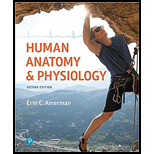
Concept explainers
To review:
Match the follicle stage with the correct description.
The follicle stages are :
Primordial follicle
Primary follicle
Secondary follicle
Vesicular follicle
Corpus luteum
Corpus albicans
The definitions are :
a. Several layers of granulosa cells with pockets of follicular fluid surround the primary oocyte.
b. Knot of whitish scar tissue.
c. Yellow glandular-looking endocrine structure.
d. A single layer of squamous follicular cells surrounds the primary oocyte.
e. One or two layers of cuboidal granulosa cells surround the primary oocyte.
f. Several layers of granulosa cells surround the secondary oocyte and project into the antrum.
Introduction:
The primary oocyte is formed from oogonia and gives rise to ova by a process known as oogenesis. The process of oogenesis takes place in the ovaries. It begins even before the female infant is born and continues till menopause. The oocyte is always present inside the ovarian follicle. The seven stages of follicle during oogenesis are primordial follicle, primary follicle, secondary follicle, vesicular follicle, ruptured follicle, corpus luteum, and corpus albicans.
Want to see the full answer?
Check out a sample textbook solution
Chapter 26 Solutions
HUMAN ANATOMY+PHYSIOLOGY-PACKAGE
- Every tutor here has got this wrong, don't copy off them.arrow_forwardSuppose that the population from question #1 (data is in table below) is experiencing inbreeding depression (F=.25) (and no longer experiencing natural selection). Calculate the new expected genotype frequencies (f) in this population after one round of inbreeding. Please round to 3 decimal places. Genotype Adh Adh Number of Flies 595 Adh Adh 310 Adhs Adhs 95 Total 1000 fladh Adh- flAdn Adh fAdhs Adharrow_forwardWhich of the following best describes why it is difficult to develop antiviral drugs? Explain why. A. antiviral drugs are very difficult to develop andhave no side effects B. viruses are difficult to target because they usethe host cell’s enzymes and ribosomes tometabolize and replicate C. viruses are too small to be targeted by drugs D. viral infections usually clear up on their ownwith no problemsarrow_forward
- This question has 3 parts (A, B, & C), and is under the subject of Nutrition. Thank you!arrow_forwardThey got this question wrong the 2 previous times I uploaded it here, please make sure it's correvct this time.arrow_forwardThis question has multiple parts (A, B & C), and under the subject of Nutrition. Thank you!arrow_forward
- Calculate the CFU/ml of a urine sample if 138 E. coli colonies were counted on a Nutrient Agar Plate when0.5 mls were plated on the NA plate from a 10-9 dilution tube. You must highlight and express your answerin scientific notatioarrow_forwardDon't copy off the other answer if there is anyarrow_forwardAnswerarrow_forward
- HAND DRAW There should be two proarrow_forwardMolecular Biology Question. Please help solve. Thanks. Please draw how two nucleotide triphosphates are linked together to form a dinucleotide, and label the 5' and 3' ends of the resulting dinucleotide.arrow_forwardWhat is a reversion in molecular biology?arrow_forward
 Medical Terminology for Health Professions, Spira...Health & NutritionISBN:9781305634350Author:Ann Ehrlich, Carol L. Schroeder, Laura Ehrlich, Katrina A. SchroederPublisher:Cengage Learning
Medical Terminology for Health Professions, Spira...Health & NutritionISBN:9781305634350Author:Ann Ehrlich, Carol L. Schroeder, Laura Ehrlich, Katrina A. SchroederPublisher:Cengage Learning Human Physiology: From Cells to Systems (MindTap ...BiologyISBN:9781285866932Author:Lauralee SherwoodPublisher:Cengage Learning
Human Physiology: From Cells to Systems (MindTap ...BiologyISBN:9781285866932Author:Lauralee SherwoodPublisher:Cengage Learning





